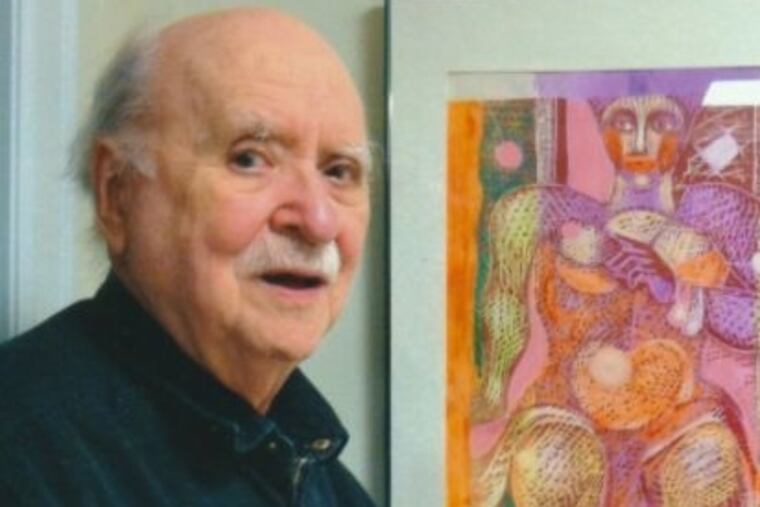Jack Gerber, Philadelphia artist and graphic designer, dies at 93
He worked for years as a graphic designer at Triangle Publications in Philadelphia, and his house was filled with his art, every room dedicated to a different medium.

Jack Gerber, 93, of Philadelphia, an accomplished artist known primarily for his bold and bright figurative paintings of everyday life, died Thursday, Jan. 14, of complications from Alzheimer’s disease and dementia at Cliveden Nursing & Rehabilitation Center in Germantown.
A painter, printmaker, draftsman, and sculptor, Mr. Gerber saw his work shown at, among other places, the Philadelphia Museum of Art, the National Academy in New York, the Corcoran Gallery in Washington, the Woodmere Art Museum in Chestnut Hill, and the Fellowship of the Pennsylvania Academy of the Fine Arts.
“He was a good guy,” said fellow artist Michael Guinn. “He was a little crusty, and he always expected to win a prize. But he had a real style.”
Noted for his “peculiar” technique, one that features blocky subjects and Art Deco colors, Mr. Gerber, who was born in 1927, embraced his art as a child.
According to a 2000 article in the Daily News by art critic Anne R. Fabbri, Mr. Gerber grew up near Cobbs Creek Park in West Philadelphia and was influenced by his father and grandfather. His grandfather inspired a love of books and intellectualism in him, and his father, a schoolteacher, encouraged his artistry as a teenager.
Mr. Gerber studied at the Fleisher Art Memorial as a youth, and, according to Fabbri, worked in watercolors with Filomena Dellaripa, painting with Maxim Gottlieb, and sculpture with Marcus Aurelius Renzetti.
After a stint in the Navy during World War II, Mr. Gerber returned to Philadelphia and used a scholarship to enroll at the School of Industrial Art, now the University of the Arts. But he was restless there, so he dropped out after a year and spent the next four years at the Pennsylvania Academy of the Fine Arts.
“Gerber didn’t conform to the academy’s ideas of art, but the maverick artist stayed the full four years,” Fabbri wrote. “His resulting style is unique by any measure.”
Influenced by the German expressionist Max Beckmann, Mr. Gerber’s form was described by Fabbri as “intensely colored figures in enigmatic spaces that look familiar, but it’s not the world we know.”
The late Edward J. Sozanski, longtime art critic at The Inquirer, wrote that Mr. Gerber’s paintings “generate an exotic ambience that’s both timeless and contemporary.”
In a short autobiography, Mr. Gerber wrote that relationships between people, and between people and animals, anchor his work. “What I really like is to present a picture and then let the viewer try to figure out the subject,” he wrote. “This way, he/she can enter into the work and maybe, if it entices enough, he/she can become a part of it.”
Despite his art education, Mr. Gerber considered himself self-taught through “reading and trying.” He was a voracious reader and listed Herman Melville, William Butler Yeats, John Keats, and Carl Jung as among his favorite writers.
He liked to read about psychology and religion, enjoyed Mexican culture, and never married. He was a frequent guest at dinner parties hosted and attended by other local artists.
“Oh, he was very talkative,” said friend and fellow artist Dorothy Roschen. “He was always up on things. Politics. Current events. He talked about all of that. He always had the TV on. I consider his work joyful and always colorful.”
Mr. Gerber belonged to, among other groups, the Philadelphia Water Color Club, the Fellowship of the Pennsylvania Academy of the Fine Arts, the Philadelphia Sketch Club, and the Plastic Club. He worked for 18 years as a graphic designer at Triangle Publications in Philadelphia.
Guinn said Mr. Gerber lived alone in North Philadelphia after his brother died years ago. His house was filled with his art, Guinn said, and every room was dedicated to a different medium.
“There was a room for painting, a room for drawing, one for pastels, for washes, and ceramics,” Guinn said. ”He was a great printmaker, and he even had a press in his basement.”
“He was so dedicated,” Roschen said. “His whole well-being was doing art.”
Mr. Gerber left no survivors. A memorial service is to be held later.